“You might as well go to Petra,” my boat captain tells me. “There won’t be anything to do on Dico for a week.” I had expressed my desire to see the ancient city in our discussions about travel.
We have been sailing in Greece all summer and my yacht, Dico, docked on the island of Milos is in need of repairs before friends from Hawaii come to sail with us. I’m excited I have a couple of days to plan my solo trip.
Another dream is about to come true! I have envisioned visiting Petra, Jordan for decades. Images of its iconic Treasury building, flanked by resting camels and colorfully robed bedouins flood my thoughts. I have felt some urgency to see middle eastern archaeological sites, as so many have been destroyed in recent years either by natural disasters, development, or radical extremists.

While I’ve traveled solo in Uganda, Italy, and the US, I have never been anywhere in the Middle East. I know that Jordan is progressive and heard stories of being invited into stranger’s homes for meals, I don’t know anything about how it is for a western woman traveling there. And what is there to experience there besides Petra?
More questions arise:
What do I wear?
Can I drink the water?
What are the customs for greetings, meals, etc?
How much time do I need in Petra?
What do I need for 24 hours in the desert?
Do I need a cell phone plan?
Is it expensive?
My research tells me I am safe and I quickly plan an itinerary: Two days in northern Jordan with a driver, a bus to Petra in the south, and a tour of the Wadi Rum desert will fit into my 6 days perfectly. I book flights, a driver, a desert tour and hotels and fly into Amman, arriving at 5 am. I get cash, a SIM card for my phone, and have booked a driver for 10 am.
I found Khallel, the driver through one of my Facebook groups (Ladies, check out The Solo Female Traveler Network, and Girls LOVE Travel) and he is a fountain of information. I learn that Jordan has no natural resources and therefore is not in conflict with other countries that would want those resources; in fact it is known as the ‘Switzerland of the Middle East.’ Tourism is the primary source of income which explains why everyone is so welcoming. While Islam is the official religion, there are many Christians and I see churches everywhere. I also notice that more are dressed in modern clothing than those in traditional Muslim robes and hijabs.
I found Khallel, the driver through one of my Facebook groups (Ladies, check out The Solo Female Traveler Network, and Girls LOVE Travel) and he is a fountain of information. I learn that Jordan has no natural resources and therefore is not in conflict with other countries that would want those resources; in fact it is known as the ‘Switzerland of the Middle East.’ Tourism is the primary source of income which explains why everyone is so welcoming. While Islam is the official religion, there are many Christians and I see churches everywhere. I also notice that more are dressed in modern clothing than those in traditional Muslim robes and hijabs.
We drive through villages, passing olive groves and open markets, as well as ultra modern shops. First stop is Jerash, a Greco-Roman city so vast it is called the ‘Pompeii of the Middle East.’ It was inhabited until 749 when it was destroyed by an earthquake, but it is still nicely preserved, with the original crossroads to Damascus, Jerusalem, and Philadelphia (Amman). The Hadrian Arch, Hippodrome, Oval Plaza, Temples of Zeus and Artemis and over a dozen churches are spread out, and it takes several hours to walk through. I see ancient wheel ruts in the marble streets, sewers and other signs of life back then.
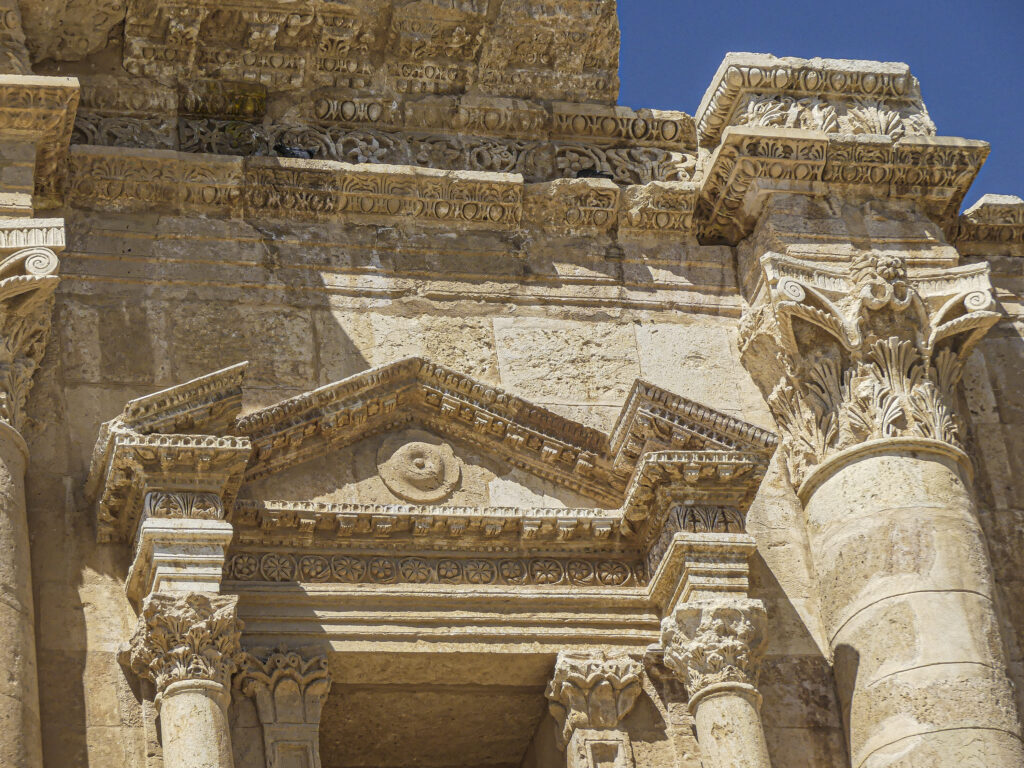
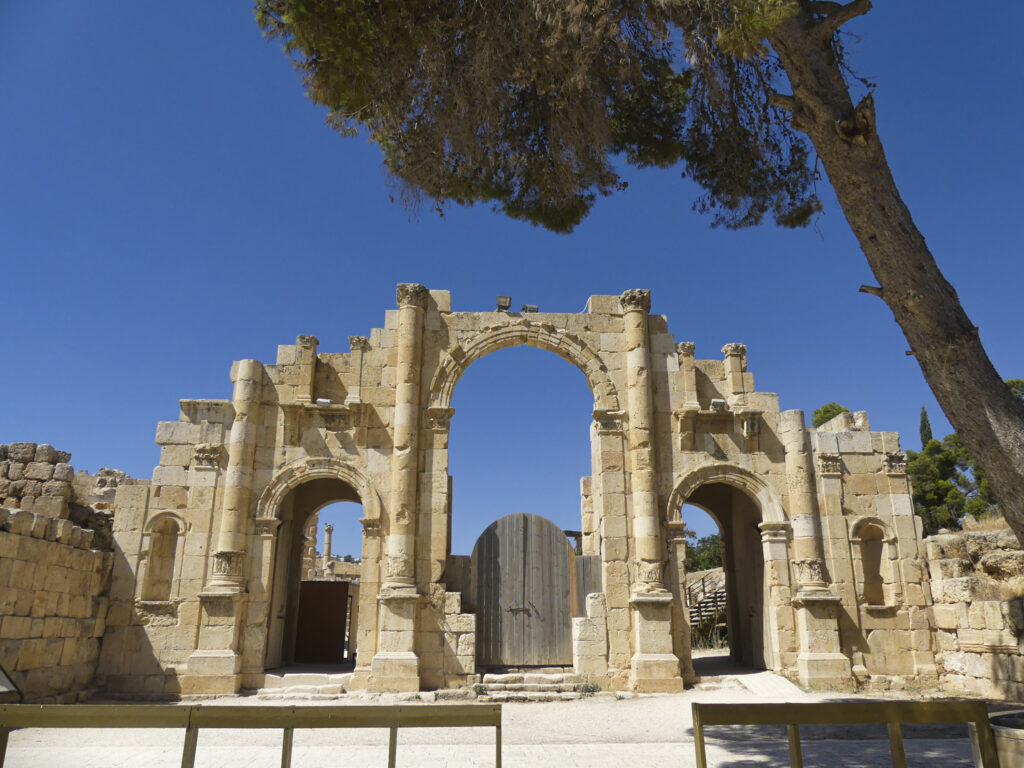

I see the layers of history and start connecting the dots…early humans were here, then Jews and Arabs, followed by Greeks and Romans, and later the Ottomans. Every inch of Jordan is a historic landmark: Bethany, the cave of Lot, Jordan River, Dead Sea, even the place where Jesus performed the miracle of the loaves and fishes.
Ajloun Castle,

a maze of passages and levels on a rocky wooded mountaintop, is a stunning Islamic fortress that dates back to the time of the Crusades. I am greeted by Issa, an attractive and knowledgeable guide who also does restoration work on ancient sites. He offers to give me a tour of the castle, which I joyfully accept! He tells me about Aljoun’s history and renovation, and shows me views of Israel from the top. I share my first tea of the trip in a tent with Issa and Khallel. I learn that the sharing of tea is a cultural welcoming that happens literally everywhere throughout the day.
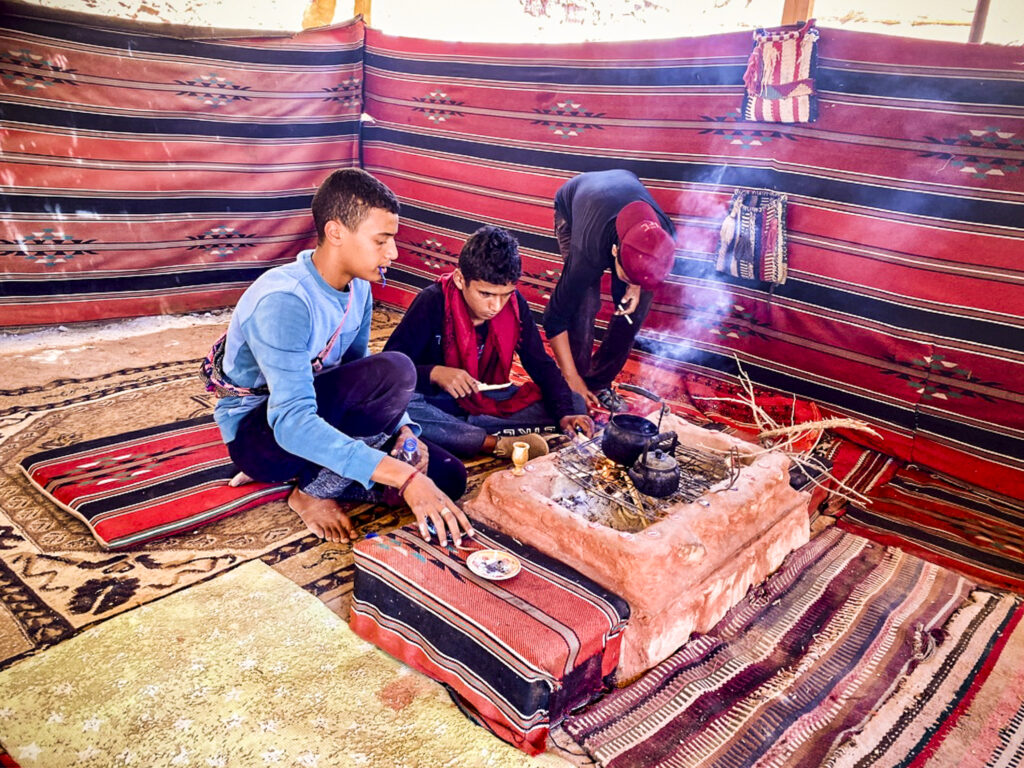
Khallel buys dates and figs from a street vendor as we drive back to Amman. The dates, actually fresh, were the most unusual I’ve ever eaten—actually fruit-like in taste, texture and appearance. I have yet to find them in the US where there are only dried dates. The spices are also scintillating!
We drive back to Amman
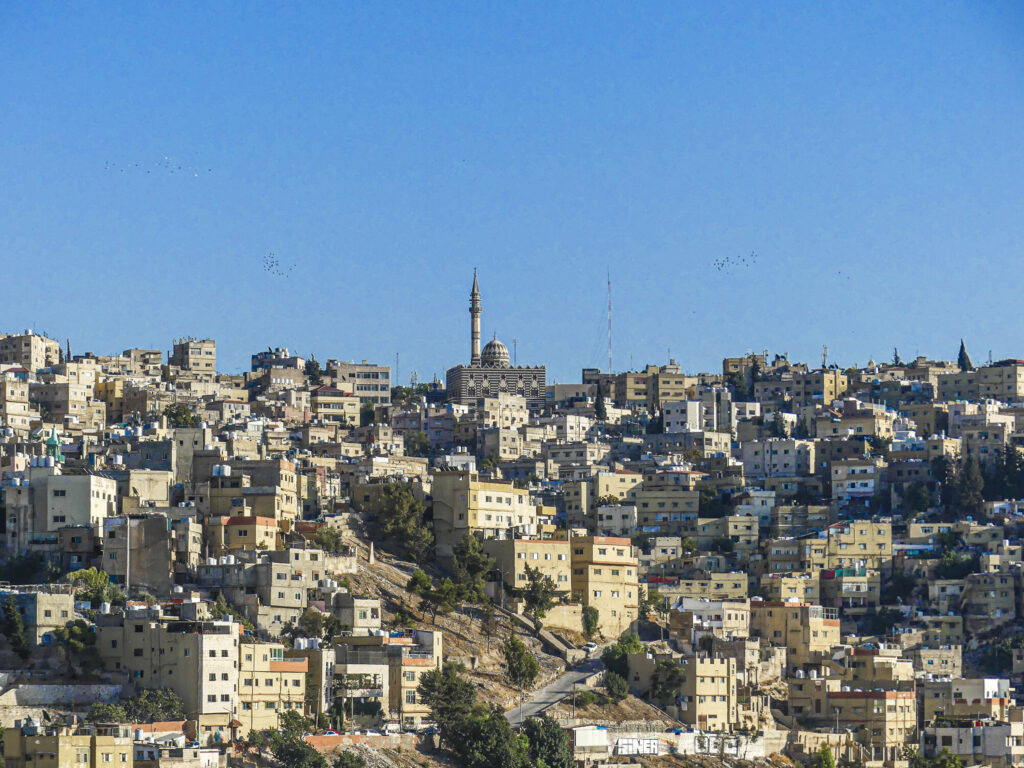
and I walk up to the ancient citadel on a hilltop in the city. The Citadel is one of the longest continuously inhabited places in the world, having been occupied by various empires —that of the Assyrians, Babylonians, the Ptolemies, the Seleucids, the Romans, Byzantines and the Umayyads. The remains of fortifications, a church and temples proudly bear witness to its past.
The next day, we head to Medaba, the ancient capital of Moab (Ruth from the Bible was a Moabite). It is called the city of mosaics, and many have been preserved. The most famous is a map of Jerusalem, which dates from the 6th century in the Greek Orthodox Basilica of St. George. Made of 2000 small stones, it is the oldest map of Jerusalem ever found. The workmanship of the mosaics is so fine that both Jordan and Italy have sponsored mosaic schools in Medaba. Yes, I did buy one!
The Roman Catholic Church of St. John the Baptist is also in Medaba. This is where the Apostle John was beheaded and the ticket includes a small museum and replica of Ruth’s tent.
Nearby, Mount Nebo hosts another cathedral and memorial to Moses, who was shown the promised land from this vantage point and is purportedly buried here. There are views of Jericho and the Jordan River, and of course, many mosaics. While it was not my intention to experience Biblical history, I found these sites made the stories come alive in my imagination.
Driving up the mountain, Khallel takes his foot off the gas and to proudly demonstrate how the earth’s magnetism can actually accelerate the car uphill. Amazing!
I conclude the day with a couple of hours at the Dead Sea. Can you swim in it? No, but you can sit in it as if you were in a recliner.
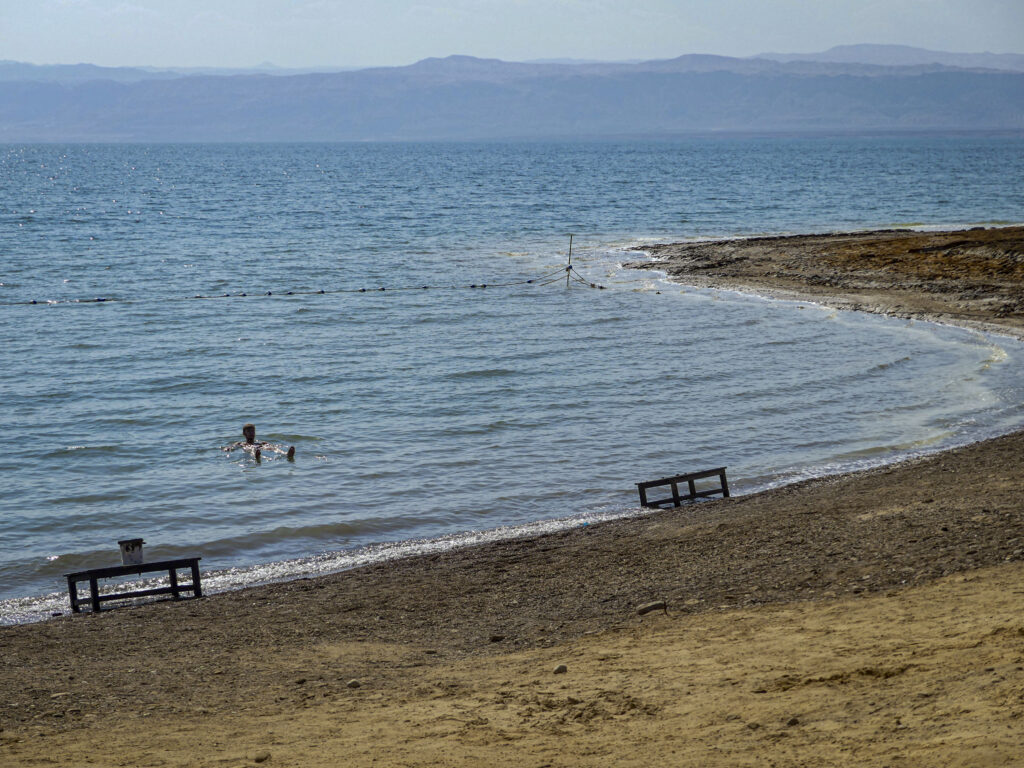
Compared to the ocean’s 3% mineral and salt composition, the Dead Sea has 33%. The mud smells horrible and will sting your eyes, but if you let it dry on your skin you will super soft skin. The medicinal effects are alleged to be numerous because of all the minerals, including The Sodium, Magnesium, Calcium, Bromine, Bitumen, Lithium and Potassium. Twelve of the minerals are found in no other sea or ocean and some are recognized for nourishing the skin, activating the circulatory systems and for easing rheumatic discomfort and metabolic disorders. I did feel relaxed with no aches and pains when I left.
I book a local bus to Petra. It is filled with foreigners, including folks from Serbia, Germany and Turkey. As I arrive mid-morning, I head straight to Petra for the day.
Petra, one of the modern Seven Wonders of the World, is filled with archaeological wonders. Over a thousand years ago, the Rose City, as it is now called, was built by the Nabatean civilization. Previously nomadic, they prospered from trade with Asia and the Middle East. Today there are Bedouins and Bdouls who live in caves on the outskirts.
I had expected a few structures, but the enigmatic city of Petra is huge! Independent buildings, along with the carved-in-stone structures, extend for miles. There’s a monastery, amphitheatre, temples, tombs, homes, churches, and much much more.


Everyone gasps as they walk through the Siq (narrow canyon) and steal a glimpse of the famous Treasury

before they emerge into the city. I only had a day but I would recommend three to really enjoy and appreciate the expanse and diversity.
Buyer beware! I have bartered in Central America and Asia, but the aggressive tactics used here were a complete shock, as were the bait-and-switch games. ‘Abdul’ approached me to make use of my free horse ride which is included in the park ticket. He talked me into taking the Indian Jones Trail, a steep and slick climb up the rocky mountain, for an undisclosed fee. Once underway, I discovered the ride became increasingly precarious.

Though I am an experienced rider, my anxiety grew with each slip and stumble.
I couldn’t get rid of my guide after that; he claimed he couldn’t get any more tourists in the afternoon and he was mine for the day. Ca-ching! Dollars multiplied. I actually friended him on social media so I could warn people not to use him, though all ended on a friendly note and I was invited to spend the evening with a group of his friends.
In fairness, I did get some lovely perspectives of the city from above the mountaintops, as photos can attest!

Back to bargaining: If you hire a donkey down the steep mountain,
or you buy a trinket, the bartering system is such that they are insulted, and loudly attack with pained expression! I later learned it’s all an act, performed to raise the price. Once you walk away and they have their money (whether you cave and pay the expected price or you give a reasonable amount), the vibe becomes peaceful again.
The Lesson: agree on an actual hard price beforehand. Good luck, as there will still be reasons why you should pay more, for example, the donkey went an extra 10 feet after it carried you down the stairs.
I plan my visit to be there one of the nights they have a light show projected onto the Treasury. Hundreds of candles dance like fairies in the sand, while colorful lights bathe the ancient wonder in even more beauty and mystique than they have by day. Don’t miss this!
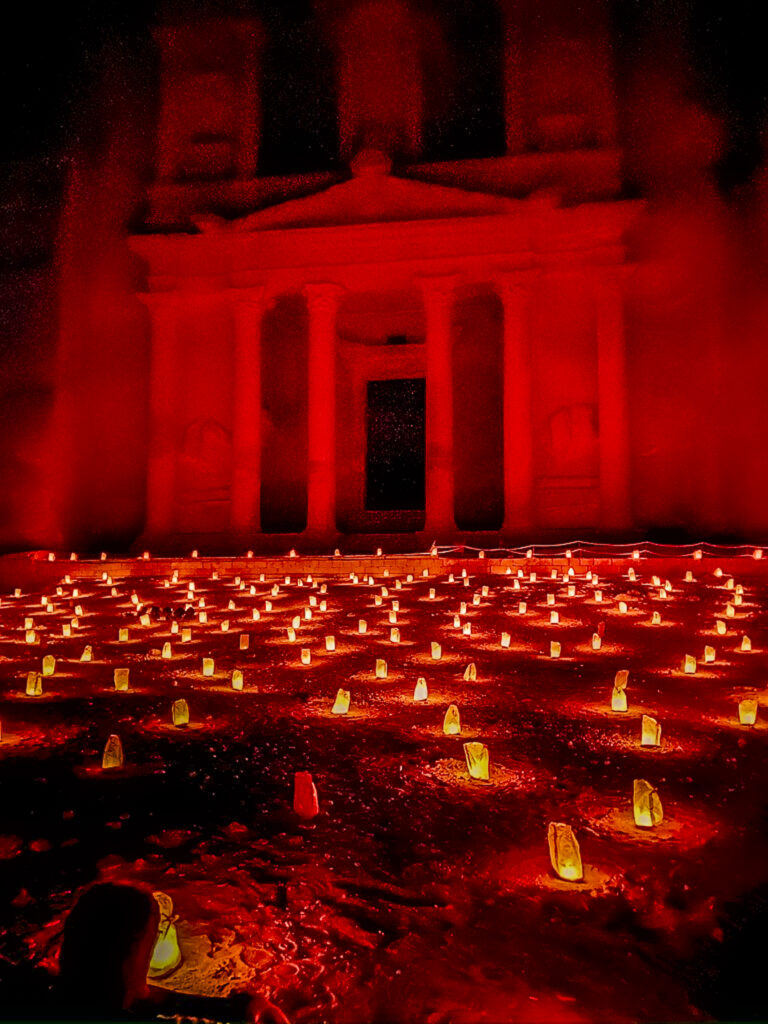
Because of my overwhelming success with the public bus, I book a minivan with others going to the Wadi Rum desert. I had reserved a jeep tour of the desert along with an overnight stay at a Bedouin camp. (https://wildwadirum.com)
When I read their opening remarks on their website I knew I had to experience this: “Welcome to Wadi Rum, the most spectacular desert scenery on earth. Its sweeping, desolate valleys of red and white sand dunes stretch for over 100km. Bounded by towering jabaal, peaks smoothed and sculpted into striking sandstone domes. Our family has been here for centuries, and we know and love the desert like an old friend.”
This is the largest wadi, or valley in Jordan. The valley is surrounded by red and yellow sandstone and granite mountains. Over time the wind carved out the weaker parts of the sandstone. Leaving the harder rock behind in all different shapes and sizes.

The Wadi Rum became famous after the Bedouins joined the Arab revolt against German and Turkish occupation in 1917 (World War I). They fought alongside Lawrence of Arabia, who wrote about them in his book. This vast desert became a protected area in 1998, with support from the World Bank to protect the environment and develop tourism.
I asked the concierge at my hotel in Petra what to bring as a gift to my Bedouin host. I was advised to buy sweets before I left Petra. Most Americans have an idea of what Baklava is, but in the Near East, there are dozens of types of baklava, each a feast for the eyes and tastebuds. I purchased a large assortment.
I register at the Visitor’s Center, pay my 5 Dinars ($7) and am met by Eid Attayiq, who drives me to his father’s home. We drive past miles of vermillion sand dunes dotted with an occasional acacia or tamarisk tree, and less often, a tented camp. We arrive at a humble house, with a makeshift pen for camels and goats. While Bedouins were nomads for thousands of years and highly skilled at surviving under the harshest conditions, many now have homes. Attayiq, Eid’s father, greets me warmly, and gratefully receives the box of sweets which he immediately shares with me and his other two guests. Wojtek and Paulina from Poland, who arrived the day before. I am grateful everyone speaks English.
I meet Attayiq’s newest (third wife) and their 3 year old son. Eid is in his 20’s, the son of Attayiq’s first wife. He explains that each wife must be given her own house and all wives must be financially supported by their husband. I ask about jealousy, and Eid admits it can be a problem. While families subsist on goat meat and milk, most of the family income results from camel breeding and selling. Tourism is growing in popularity among the bedouins, especially the Zalabia tribe, to which this family belongs. With scant resources, I count this tour as a blessing not only for me, but for this family.


We set out in an old, dusty Jeep with a bench under a covered platform on the roof. I soon learn this is the coolest spot to sit as the vehicle gets quite hot in the desert sun.
There are some tracks of hardened sand, but we also seem to be sliding aimlessly through deep powder past crimson sand dunes, camel trekkers in red-and-white checked veils, and small herds of hobbled camels. I wonder what these hard-working beasts eat and drink, how often, and how their owners locate them, as fences don’t exist, and they blend in with the beige sand. They can’t go far with their feet tied together, but they are resourceful creatures!
In the distance, a huge rock formation emerges, looming larger. We are told this is where Lawrence’s Spring is. The military hero would climb up the hill after returning to camp, and relax in the cool water that flowed from a crevice in the rocks. The tiny pool is a mini oasis, with lush green vegetation. In the desert one begins to notice that what appear to be small subtle features are profoundly significant. The next available water is dozens of kilometers away; for nomads it could mean the difference between life and death.
After a soujourn in a brightly colored tent for Bedouin tea, we arrive at Khazali Canyon, a huge red rock formation with a slot canyon. Its inner walls are covered with Thamudic, Nabatean, and Islamic inscriptions some dating to 700 BCE, as well as petroglyphs depicting humans and animals. The red formation reminds me of Ayer’s Rock, aka Uluru in Australia, and these Anfeshiyya inscriptions as they are called, are similar to Anasazi drawings in the American southwest. The most unusual images are those of bare feet; it is assumed they had religious significance.


My imagination filled me with romantic ideas of early humans expressing their respect for life, as well as their gratitude for food provided by the animals depicted.
We stop again at at a colorful camp for tea and Bedouin music.

Attayiq joins a couple of other musicians for an impromptu concert by lute-like oud player. He is accompanied by a drummer playing the goblet -shaped darbuka drum. They sing several haunting pieces while we relax and sip our tea. Knowing the oud originated prior to 3200 BCE, I envision these same songs being sung on similar instruments hundreds of years ago.
The Wadi Rum is known for several arches, each more grand than the last. The small arch is impressive, but upon arriving at Um Frouth Rock Bridge, I’m convinced there is nothing more magnificent, even compared to the American desert southwest. Looking from the ground up at this massive arch inspires a sense of awe. A massive stone slab balances between two tall peaks. It’s a bit of a clamber to the top, up a smooth slope and along a rocky edge. Thankfully handholds have been carved into it for tourists. The climb does not disappoint as the views of this desolate expanse are spectacular!

We stop in the shade of another massive outcropping. Attayiq, gets a gas canister and pot out of his car. He and Paulina chop vegetables. While the food cooks, he stops to pray, prostrating on the sand several times. After we enjoy a tasty stew for lunch, there is time for a siesta, and once again, we are underway, passing miles of beige and rust terrain.
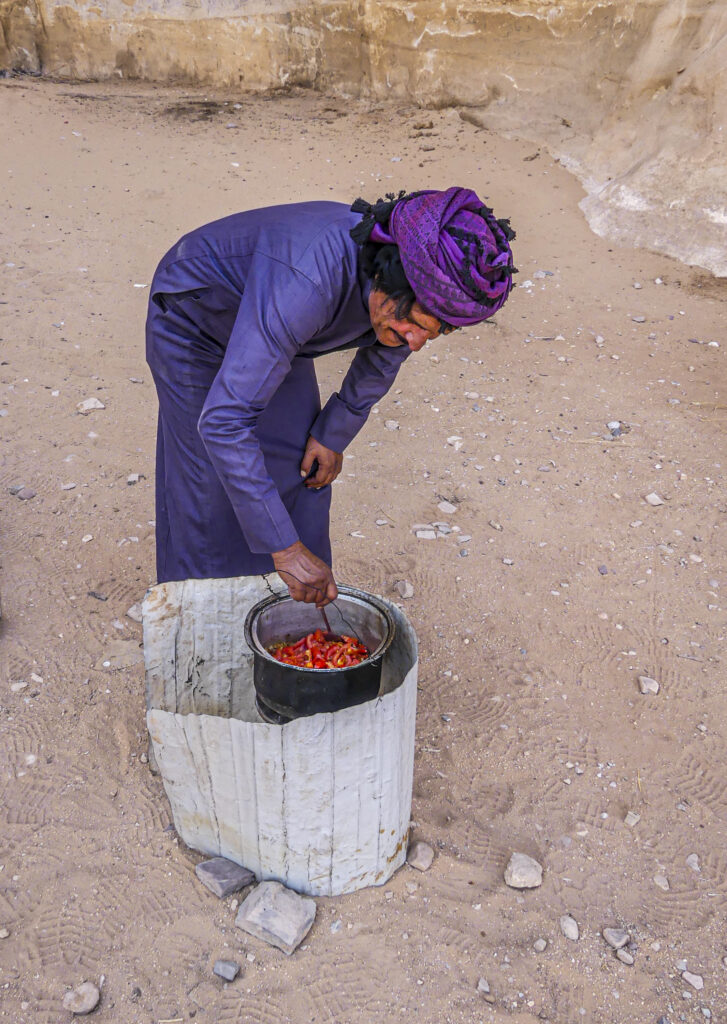
I thought I had seen the biggest and best of the stone archways, until we arrived at Burdah Rock Bridge. We join several other jeeps, below the magnificent arch. Dozens scuttle up the khaki colored rock, posing for the guides below. Two young women perch on the arch, posing in flowing gowns, their Instagram wardrobe suitcases off to the side. I await a couple of costume changes before I get my chance to scale the promontory. As I view the expanse of sand and rock, I am humbled by the fragility of we humans, along with the ingenuity, skill and bravery of those who thrive here.
Among the vast expanses of crimson sand, the Red Sand Dune, or ‘Al Hasany’ in Arabic, is one of the most famous ones. The red color is caused by iron oxide and the sand is very deep, making for a strenuous climb up as the sand falls away beneath your feet. If the weather allows, you can actually walk up barefoot because the sand is fine and soft. Some tours allow sand boarding down the dunes. See how tiny Wojtek and Paulina appear as they climb?

From the top of Al Hasany, there are incredible panoramic views. It is easy to see why many shots from the Lawrence of Arabia film included these views. I also enjoy watching children race to the top and slide down the dune, giggling with glee.
We stop to watch a spectacular sunset enveloping the entire desert in golden light,
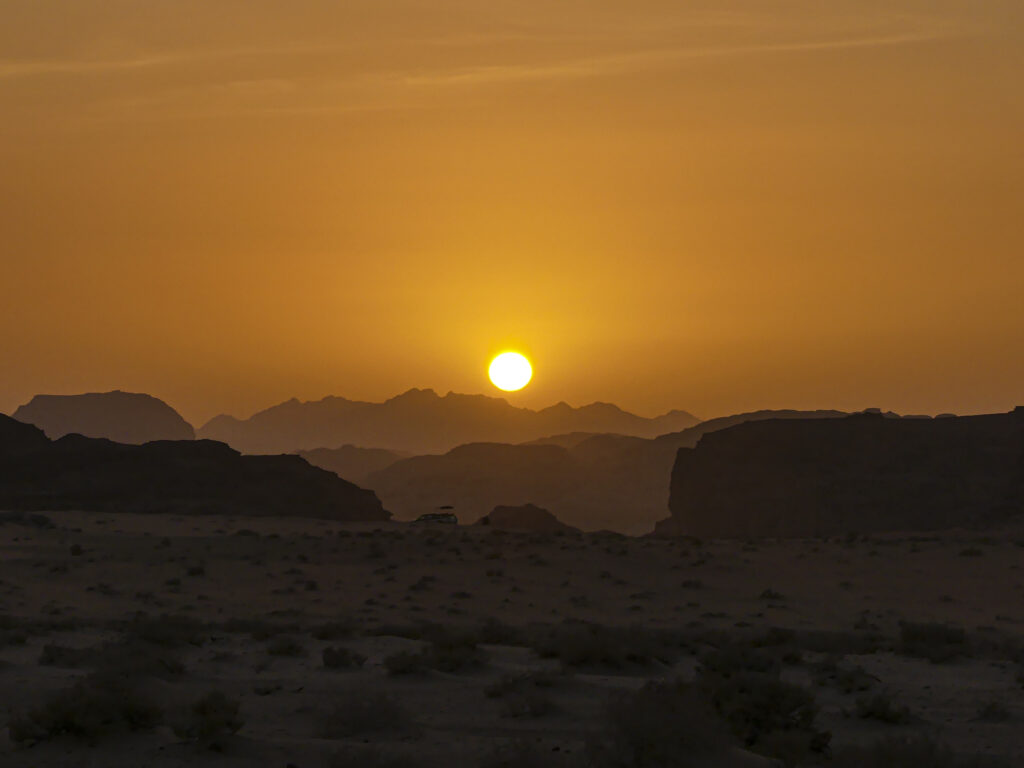

and then arrive at Attayiq’s tented camp, composed of fabric over a wooden frame.
A large building is filled with carpets and tables, as food is being prepared. We sit on carpets by the fire as the stars emerge, and several men play Bedouin music as we stare, transfixed by the melodies, sparks, flames, and glittering sky. After a dinner of local delights, we sleep.
In the morning I am taken to see another of Attayiq’s sons. He traps hawks and kestrels and sells them after training them to hunt for humans. This is a second source of income for the family. Attayiq wanted me to see the birds because he knew I had rehabbed raptors before. The family is quite resourceful.

While Petra was darned impressive, I actually enjoyed my time in the Wadi Rum more than any other time in Jordan. The best way to experience a culture is to immerse yourself in it. I only wish I had more time before returning to the boat.
Please let me know your thoughts about this trip.
LINKS:
http://wadirum.jo/things-to-see-and-do/sites-of-interest/
Facebook: Girls LOVE Travel
The Solo Female Traveler Network
